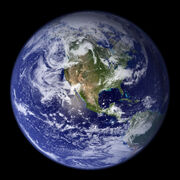
The planet Earth
Earth analog (also known as Twin Earth, Earth Twin, Second Earth, Extrasolar Earth, Alien Earth, Earth II or Earth-like planet) is another planet, with environmental conditions similar to Earth.
The possibility of an Earth analog is of particular interest to humans, as it is easily inferred that the more similar a planet is to Earth, the more likely it is of sustaining Earth-like complex extraterrestrial life and civilization. As such, the subject has long been speculated in science, philosophy, science fiction and popular culture. Advocates of space colonization have long sought an Earth analog as a "second home" while advocates for space and survival would regard such a planet as a potential "new home" for mankind.
Before the scientific search for and study of extrasolar planets, the possibility was argued through philosophy and science fiction. The 'Rare Earth hypothesis' suggests that Earth-like planets are extremely rare, and there are very few, if any, in the universe, but the Mediocrity principle suggests that Earth-like planets should be common in an infinite universe.
Some scientific theories speculate that Earth analogs may have existed in our Solar System in the past. In the future, technology may be used by humans to produce an 'earth analog'. In theory, terraforming could potentially create such a world.
The Multiverse theory suggests that an Earth analog could exist in another universe or even be another version of the Earth itself in a parallel universe.
Technological advances in extrasolar planet detection are rapidly refining the probabilities of a real discovery, not just in the universe, but in the present Milky Way galaxy, though distribution and attributes are still very much unknown. Different studies on the frequency of Earth-like planets in the Milky Way have resulted in estimation varying from one (i.e. the Earth) to billions. Current calculations tend to indicate that they may be relatively common in the universe.
On November 4, 2013, astronomers reported, based on Kepler space mission data, that there could be as many as 40 billion Earth-sized planets orbiting in the habitable zones of Sun-like stars and red dwarf stars within the Milky Way galaxy. 11 billion of these estimated planets may be orbiting Sun-like stars. The nearest such planet may be 12 light-years away.
Attributes and criteria[]
The probability of actually finding an Earth-like planet mostly depends on the attributes that are expected to be similar to Earth, but these very greatly. Generally, it is considered that it would be a terrestrial planet, and there have been several scientific studies aimed at finding such planets. Often implied, but not limited to such criteria are planet size, surface gravity, mass, star size and star type (i.e. Solar analog), orbital distance and stability, axial tilt and rotation, oceans, air, weather conditions, strong magnetosphere, and sometimes the presence of Earth-like complex life (possibly through convergent evolution or parallel evolution). If there is complex life, there may be forests covering parts of the land. If there is intelligent life, there may be cities covering parts of that land. Some things that are assumed of such a planet, however, may be unlikely due to Earth's own history. For instance, the Earth's atmosphere was not always oxygen-rich and this is a biosignature from the emergence of photosynthetic life. The formation, presence, influence on these characteristics of the Moon (such as tidal forces) may also pose a problem in finding an Earth analog.